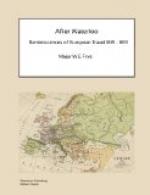There are some pleasant promenades in the environs of Leipzig; but this is not a time of the year to judge of the beauty of the country. I went, however, to view the house occupied by Napoleon on the eve of the battle of Leipzig. A monument is to be erected to the memory of Poniatowsky in the spot where he perished.
I started from Leipzig on 7th March at eleven o’clock. I was five days en route from Leipzig to Frankfort, tho’ the distance does not exceed forty-five German miles. I travelled in the diligence, but had I known that the arrangements were so uncomfortable, I should have preferred going in a Landkutsche, which would have made the journey in seven days and afforded me an opportunity of stopping every night to repose; whereas in the diligence, tho’ they go en poste, they travel exceedingly slow and it is impossible to persuade the postillion to accelerate his usual pace. He is far more careful of his horses than of his passengers. This I however excuse; but it is of the frequent stoppages and bad arrangement of them that I complain. Instead of stopping at some town for one whole night or two whole nights out of the five, they stop almost at every town for three, four and five hours; so that these short stoppages do not give you time enough to go to bed and they are besides generally made in the day time or early in the morning and evening. We passed thro’ the following cities and places of eminence, viz., Lutzen; the spot where Gustavus Adolphus was killed is close to the road on the left hand with a plain stone and the initials G.A. inscribed on it. Weimar is a very neat city and where I should like much to have staid; but I had only time to view the outside of the Palace and the Stadthaus. Erfurt and Gotha are both fine looking cities. In Gotha I had only time to see the outside of the Residenz Schloss or Ducal Palace, which is agreeably situated on an eminence, and to remark in the Neumarkt Kirche the portrait of Duke Bernard of Saxe Weimar and the monuments of the princes of that family. At Erfurt there is the tomb of a Count Gleichen who was made prisoner in the Holy Land, in the time of the Crusades, and was released by a Mahometan Princess on condition of his espousing her. The Count was already married in Germany and there he had left his wife; but such was his gratitude to the fair Musulmane, that he married her with the full consent of his German wife and they all three lived happily together. Fulda, where we stopped four hours, appears a fine city, and is situated on an eminence commanding a noble view of a very fertile and extensive plain. The Episcopal Palace and the churches are magnificent, and the general appearance of the town is striking. The Bishopric of Fulda was formerly an independent ecclesiastical state, but was secularised at the treaty of Luneville and now forms part of the territory of Hesse-Cassel.




